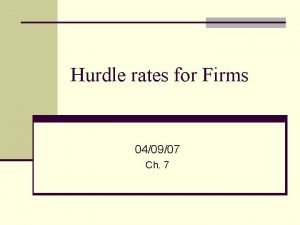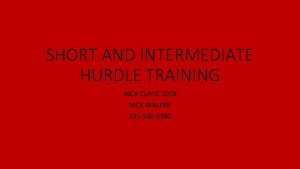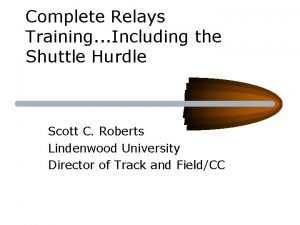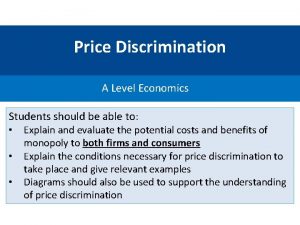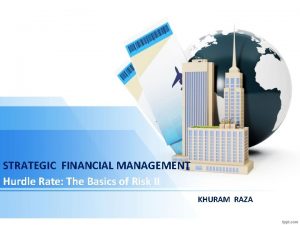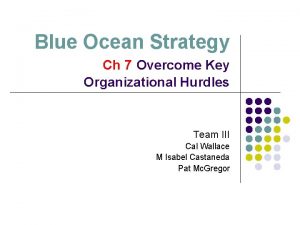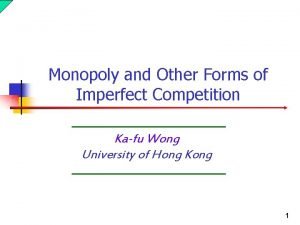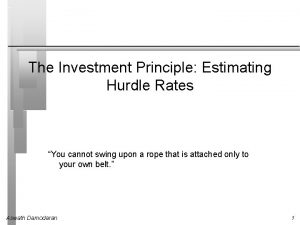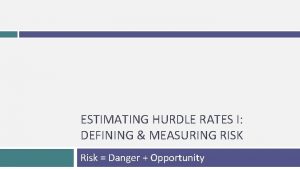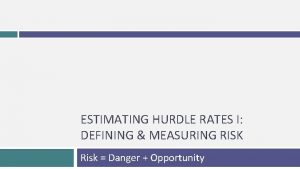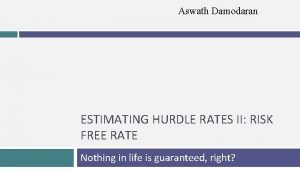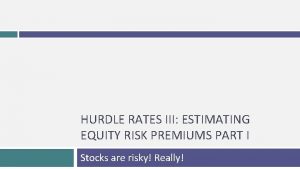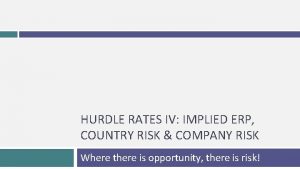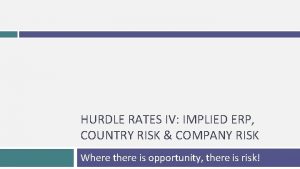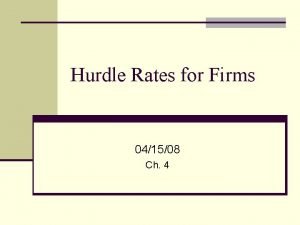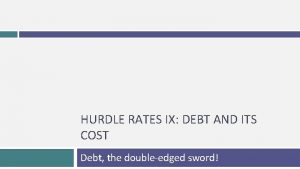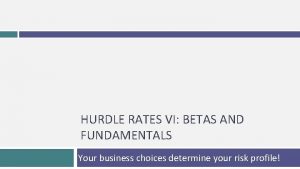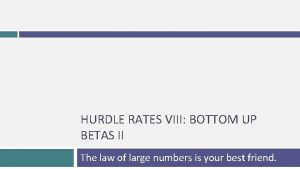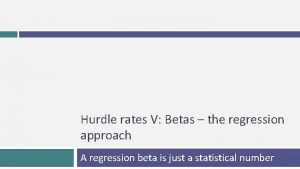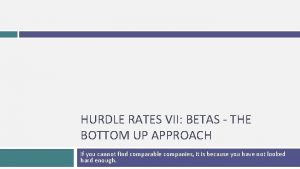ESTIMATING HURDLE RATES I DEFINING MEASURING RISK Risk



















- Slides: 19

ESTIMATING HURDLE RATES I: DEFINING & MEASURING RISK Risk = Danger + Opportunity


First Principles 3

The notion of a benchmark Since financial resources are finite, there is a hurdle that projects have to cross before being deemed acceptable. This hurdle will be higher for riskier projects than for safer projects. A simple representation of the hurdle rate is as follows: Hurdle rate = Riskless Rate + Risk Premium The two basic questions that every risk and return model in finance tries to answer are: How do you measure risk? How do you translate this risk measure into a risk premium? 4

What is Risk? Risk, in traditional terms, is viewed as a ‘negative’. Webster’s dictionary, for instance, defines risk as “exposing to danger or hazard”. The Chinese symbols for risk, reproduced below, give a much better description of risk: 危机 The first symbol is the symbol for “danger”, while the second is the symbol for “opportunity”, making risk a mix of danger and opportunity. You cannot have one, without the other. Risk is therefore neither good nor bad. It is just a fact of life. The question that businesses have to address is therefore not whether to avoid risk but how best to incorporate it into their decision making. 5

A good risk and return model should… 6 1. 2. 3. 4. 5. It should come up with a measure of risk that applies to all assets and not be asset-specific. It should clearly delineate what types of risk are rewarded and what are not, and provide a rationale for the delineation. It should come up with standardized risk measures, i. e. , an investor presented with a risk measure for an individual asset should be able to draw conclusions about whether the asset is above-average or below-average risk. It should translate the measure of risk into a rate of return that the investor should demand as compensation for bearing the risk. It should work well not only at explaining past returns, but also in predicting future expected returns. Aswath Damodaran 6

The Capital Asset Pricing Model 7 1. 2. 3. 4. Uses variance of actual returns around an expected return as a measure of risk. Specifies that a portion of variance can be diversified away, and that is only the non-diversifiable portion that is rewarded. Measures the non-diversifiable risk with beta, which is standardized around one. Translates beta into expected return Expected Return = Riskfree rate + Beta * Risk Premium 5. Works as well as the next best alternative in most cases. Aswath Damodaran 7

1. The Mean-Variance Framework 8 The variance on any investment measures the disparity between actual and expected returns. Low Variance Investment High Variance Investment Expected Return Aswath Damodaran 8

2. The Importance of Diversification: Risk Types 9 Aswath Damodaran 9

The Role of the Marginal Investor 10 The marginal investor in a firm is the investor who is most likely to be the buyer or seller on the next trade and to influence the stock price. Generally speaking, the marginal investor in a stock has to own a lot of stock and also trade that stock on a regular basis. Since trading is required, the largest investor may not be the marginal investor, especially if he or she is a founder/manager of the firm (Larry Ellison at Oracle, Mark Zuckerberg at Facebook) In all risk and return models in finance, we assume that the marginal investor is well diversified. Aswath Damodaran 10

3. The Limiting Case: The Market Portfolio 11 The big assumptions & the follow up: Assuming diversification costs nothing (in terms of transactions costs), and that all assets can be traded, the limit of diversification is to hold a portfolio of every single asset in the economy (in proportion to market value). This portfolio is called the market portfolio. The consequence: Individual investors will adjust for risk, by adjusting their allocations to this market portfolio and a riskless asset (such as a T-Bill): Preferred risk level No risk Some risk A little more risk Even more risk A risk hog. . Aswath Damodaran Allocation decision 100% in T-Bills 50% in T-Bills; 50% in Market Portfolio; 25% in T-Bills; 75% in Market Portfolio 100% in Market Portfolio Borrow money; Invest in market portfolio 11

4. The Risk of an Individual Asset 12 The essence: The risk of any asset is the risk that it adds to the market portfolio Statistically, this risk can be measured by how much an asset moves with the market (called the covariance) The measure: Beta is a standardized measure of this covariance, obtained by dividing the covariance of any asset with the market by the variance of the market. It is a measure of the non-diversifiable risk for any asset can be measured by the covariance of its returns with returns on a market index, which is defined to be the asset's beta. The result: The required return on an investment will be a linear function of its beta: Expected Return = Riskfree Rate+ Beta * (Expected Return on the Market Portfolio - Riskfree Rate) Aswath Damodaran 12

Alternatives to the CAPM 13

Limitations of the CAPM 1. The model makes unrealistic assumptions 2. The parameters of the model cannot be estimated precisely 3. The model does not work well - If the model is right, there should be a linear relationship between returns and betas the only variable that should explain returns is betas - The reality is that the relationship between betas and returns is weak Other variables (size, price/book value) seem to explain differences in returns better. 14

Why the CAPM persists… The CAPM, notwithstanding its many critics and limitations, has survived as the default model for risk in equity valuation and corporate finance. This is because: The alternative models do a much better job than the CAPM in explaining past return, but not much better in estimating expected future returns. The alternative models are more complicated and require more information For most companies, the expected returns you get with the alternative models is not different enough to be worth the extra trouble. 15

Gauging the marginal investor: Disney in 2009 16

Extending the assessment of the investor base In all five of the publicly traded companies that we are looking at, institutions are big holders of the company’s stock. 17

6 Application Test: Who is the marginal investor in your firm? Looking at the breakdown of stockholders in your firm, consider whether the marginal investor is An institutional investor An individual investor An insider B DES Page 3 PB Page 13 18

Task Who is the marginal investor in your firm? 19 Read Chapter 3
 Prepositions in relative clauses
Prepositions in relative clauses Oraciones defining y non defining
Oraciones defining y non defining Defining relative clause meaning in telugu
Defining relative clause meaning in telugu Relative clauses defining and non defining
Relative clauses defining and non defining Adjectival clauses
Adjectival clauses Relative clauses defining and non defining
Relative clauses defining and non defining Ratios rates and unit rates
Ratios rates and unit rates Unit rate
Unit rate Proportions guided notes
Proportions guided notes Ratios rates and unit rates
Ratios rates and unit rates Hurdle rate
Hurdle rate Intermediate hurdle drills
Intermediate hurdle drills Ramell scott hurdle
Ramell scott hurdle Hurdle model of price discrimination
Hurdle model of price discrimination Hurdle rate
Hurdle rate Cognitive hurdle
Cognitive hurdle Four organizational hurdles to strategy execution
Four organizational hurdles to strategy execution Calculus vs algebra
Calculus vs algebra Hurdle technology
Hurdle technology First principle estimating
First principle estimating










